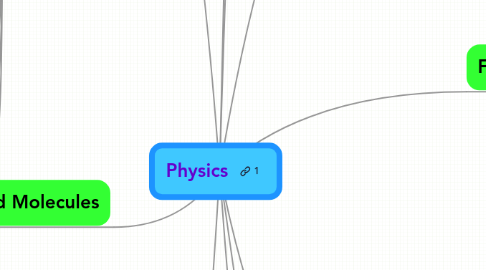
1. Radiation
1.1. Sound waves
1.1.1. Combining waves
1.2. Light
1.2.1. Moving waves
1.2.1.1. New node
1.2.2. Combining waves
1.2.3. Using mirrors and lenses
1.2.4. Radiation and decay
1.2.5. Quantum theory
1.3. Electromagnetic waves
1.3.1. Moving waves
1.3.1.1. New node
1.3.2. Combining waves
1.3.3. Using mirrors and lenses
1.3.4. Radiation and decay
1.3.5. Quantum theory
1.4. Nuclear radiation
1.4.1. The nuclear atom
1.4.1.1. New node
1.4.2. Radiation and decay
1.4.3. Electromagnetic waves
1.4.3.1. Light
1.5. Waves and Ray
2. Density and Pressure
2.1. Pressure in liquids
2.1.1. Liquid and gas pressure
2.2. Upthrust and flotation
2.2.1. Liquid and gas pressure
2.3. Pressure in gases
2.3.1. Liquid and gas pressure
2.3.2. The behaviour of gases
2.3.3. Kinetic theory
2.4. Motion, mass and forces
3. Atoms and Molecules
3.1. Structure of solids
3.1.1. Solids, stresses, and strains
3.2. Thermal motion
3.2.1. Temperature
3.2.1.1. New node
3.2.2. Internal energy, heat, and work
3.2.3. Kinetic theory
3.2.4. Heat transfer
3.3. Structure of atoms and nuclei
3.3.1. The nuclear atom
3.3.1.1. New node
3.3.2. Nuclear energy
3.3.3. Quantum theory
3.4. Electrons in motion
3.4.1. Current and resistance
3.4.1.1. New node
3.4.2. Charged particles in motion
3.4.3. Heat transfer
3.4.4. Quantum theory
3.5. Work,energy,and power
3.5.1. New node
3.6. Atoms and molecules in motion
4. Enerygy
4.1. Type 1
4.1.1. Kinetic energy
4.1.1.1. Work, energy and momentum
4.1.1.2. Charged particles in motion
4.1.1.3. Kinetic theory
4.1.2. Potential energy
4.1.2.1. Gravitation
4.1.2.1.1. New node
4.1.2.2. Electric charges and fields
4.1.2.3. Nuclear energy
4.1.3. Energy stored
4.1.3.1. Capacitors and fields
4.1.3.1.1. New node
4.1.3.2. Solids, stresses, and strains
4.1.3.3. Internal energy, heat, and work
4.1.4. Nuclear energy
4.1.4.1. Nuclear energy
4.1.4.1.1. New node
4.2. Type 2
4.2.1. Energy transferred by collision
4.2.1.1. Work, energy and momentum
4.2.2. Energy transferred by waves
4.2.2.1. Moving waves
4.2.2.1.1. New node
4.2.2.2. Heat transfer
4.2.2.3. Quantum theory
4.2.3. Energy transferred by current
4.2.3.1. Current and resistance
4.2.3.2. Alternating current1
4.2.3.3. Alternating current 2
4.2.4. Energy transferred by heat
4.2.4.1. Heat transfer
4.2.4.1.1. New node
4.2.5. Thermodynamics
4.2.5.1. Temperature
4.2.5.1.1. New node
4.2.5.2. Internal energy, heat, and work
4.3. Work,energy,and power
4.4. Atoms and molecules in motion
4.5. Charges and circuits
5. Properties of Materials
5.1. Physical
5.1.1. Solids, stresses, and strains
5.1.2. Liquid and gas pressure
5.1.3. The behaviour of gases
5.2. Thermal
5.2.1. Temperature
5.2.1.1. New node
5.2.2. Internal energy, heat, and work
5.2.3. The behaviour of gases
5.2.4. Kinetic theory
5.2.5. Heat transfer
5.3. Electrical
5.3.1. Capacitors and fields
5.3.1.1. New node
5.3.2. Current and reistance
5.4. Magnetic
5.4.1. Magnetic fields and forces
5.4.1.1. New node
5.5. Optical
5.5.1. Moving waves
5.5.1.1. New node
5.6. Motion, mass and forces
5.7. Work, energy, and power
5.8. Atoms and molecules in motion
5.9. Charges and circuits
5.10. Magnets and currents
5.11. Waves and rays
6. Oscillations and waves
6.1. Oscillatory motion
6.1.1. Cycles, oscillations, and SHM
6.1.2. More motion graphs
6.2. Alternating current
6.2.1. Alternating current 1
6.2.1.1. New node
6.2.2. Alternating current 2
6.3. Waves and their effects
6.3.1. Moving waves
6.3.1.1. New node
6.3.2. Combining waves
6.3.3. Using mirrors and lenses
6.3.4. Heat transfer
6.3.5. Radiation and decay
6.4. Waves and rays
7. Charges and Currents
7.1. Charge
7.1.1. Electric charges amd fields
7.1.2. Capacitors and fields
7.1.3. Current and resistance
7.1.4. Charged particles in motion
7.2. DC circuit
7.2.1. Electromagnetism
7.2.1.1. Magnetic fields and forces
7.2.1.1.1. New node
7.2.1.2. Electromagnetic induction
7.2.1.3. Charged particles in motion
7.2.2. AC circuits
7.2.2.1. Electromagnetic induction
7.2.2.1.1. New node
7.2.2.2. Alternating current 1
7.2.2.3. Alternating current 2
7.2.3. Current and resistance
7.2.3.1. New node
7.2.4. Analysing circuits
7.3. Charges and circuits
7.4. Magnets and currents
8. Basic Ideas
8.1. Foundations
8.1.1. Motion, mass and forces
8.1.2. Work, energy, and power
8.1.3. Atoms and molecules in motion
8.1.4. Charges and circuits
8.1.5. Magnets and currents
8.1.6. Waves and rays
8.2. Units and dimensions
8.2.1. Units and dimensions
8.2.1.1. New node
8.3. Experimental measurements
8.3.1. Measurement, uncertainties, and graphs
9. Force and motion
9.1. Combined forces
9.1.1. Vectors
9.1.2. Moments and equilibrium
9.2. Linear motion
9.2.1. Analysing motion
9.2.1.1. New node
9.2.2. Motion and momentum
9.2.3. Work, energy and momentum
9.2.4. Cycles, oscillations, and SHM
9.2.5. More motion graphs
9.2.6. Charged particles in motion
9.3. Circular and rotational motion
9.3.1. Circular orbits..and rotation
9.3.1.1. New node
9.4. Turning effects of forces
9.4.1. Vectors
9.4.2. Moments and equilibrium
9.5. Gravitational forces
9.5.1. Gravitation
9.5.1.1. New node
9.5.2. Circular orbits...and rotation
9.6. Electric forces
9.6.1. Electric charges and fields
9.6.1.1. New node
9.6.2. Charged particles in motion
9.7. Magnetic forces
9.7.1. Magnetic fields and forces
9.7.1.1. New node
9.7.2. Charged particles in motion
9.8. Motion, mass and forces
10. Fields
10.1. Gravitaional fields
10.1.1. Gravitation
10.1.2. Circular orbits...and rotation
10.2. Electric fields
10.2.1. Electric charges and fields
10.2.1.1. New node
10.2.2. Capacitors and fields
10.3. Magnetic fields
10.3.1. Magnetic fields and forces
10.3.1.1. New node
10.3.2. Electromagnetic induction
